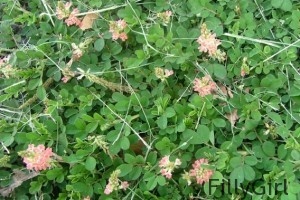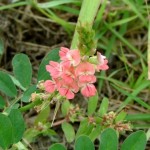Creeping Indigo (Indigofera spicata and Indigofera hendecaphylla) is a perennial legume that was once thought to hold great promise as a fodder that could form well-balanced mixtures with grasses. It was brought to the state of Florida in the United States in 1925 (from Africa) and it was also imported as a potential pasture legume by Australia. In general, creeping indigo can be found around the world in disturbed grasslands, lawns, road sites, waste sites, and trails.
While creeping indigo is indeed a good nitrogen fixer, and thus makes for a good cover crop or green manure for soil enrichment, it is bad for use as forage or pasture. Why? Because creeping indigo is toxic to horses and many other animals including cattle, sheep, goats, rabbits, chickens, and guinea pigs. In the United States, creeping indigo’s toxicity was thought to be questioned as early as 1933. By the 1940’s, its toxicity to rabbits was clearly established through a series of trials. With both rabbits and cattle, small doses of creeping indigo in their feed cause no harm, but once the concentration of the legume exceeds about 50% of the forage, the animals start to show signs of toxicity. In Australia, ponies grazing a pasture containing 24% Indigofera spicta showed signs of poisoning and had to be euthanized. Symptoms of cattle poisoning include anorexia, muscular twitching, dullness, aimless walking, alternating diarrhea and constipation, stillborn calves, and abortion. Horses suffer from central nervous system disturbances, with seizures, ulcerations, redness of the gums, and miscarriages the most common symptoms. Once a horse is poisoned by creeping indigo there is little chance of recovery.
The irony is that almost all animals, except for pigs, love this stuff. One horse owner, who recently lost her horse, described it as “candy for horses” and believes animals become addicted to it. Creeping Indigo can be identified by its hairy, creeping stems. Its leaves feature seven to nine leaflets and are also hairy. Creeping Indigo produces numerous pink flowers in warm months on spikes from the bases of its leaves. Because the plant reproduces by seed, it is easily spread. And with roots that can extend two feet into the ground, they can be hard to destroy.
Creeping indigo is pervasive around the world, and despite no longer being used or wanted in the United States, creeping indigo has become invasive in many areas (including Central Florida, Southern Florida, and Puerto Rico) where it was first introduced for forage or cover crop. The last fatal case of creeping indigo was reported just last week in Florida, which is why we are trying to inform FillyGirl Fans and remind those already “in the know” about creeping indigo to stay vigilant. Walk or ride through your pastures, inspecting them regularly. Also, check the perimeter of your property and peer over your neighbor’s fence. If your neighbor’s land becomes over-run with this dangerous weed/”heroin to horses,” it’s only a matter of time before the seeds spread to your property. So educate your neighbors as well and tell them what to look out for. You’ve got to stay on the offensive with this one. If you catch it too late, it’s not only fatal for the animals (minus the pigs) on your property, but it’s super difficult to get rid of. Some have had to resort to a scorched earth tactic- literally!










I just read that creeping indigo depletes amino acid arginine.Horses supplemented with peanut or cottonseed meal are protected fom these toxins.Could someone please verify this.Thanks